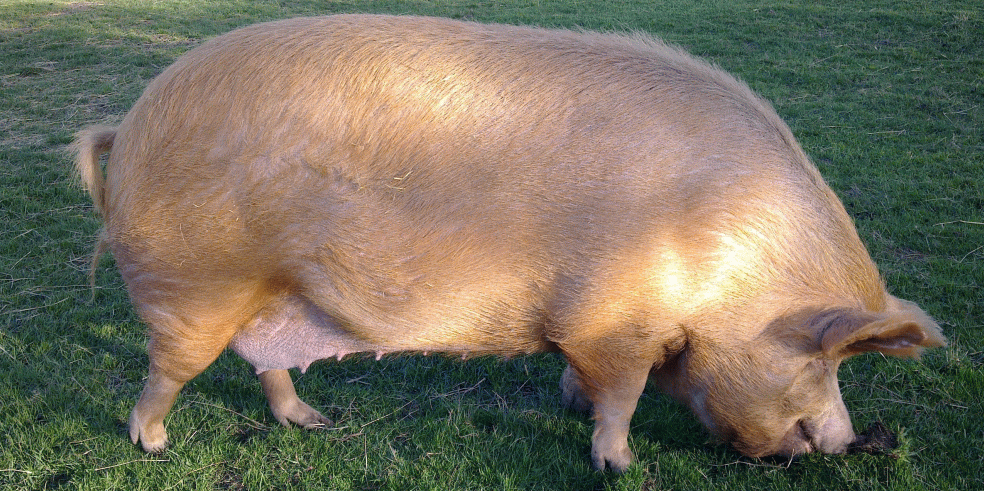HebrideanSheep.com

Rare Tamworth PigsWe occasionally are able to offer pork and old fashioned pork sausages from one of our small family of Tamworth pigs – whose meat is prized by chefs and gourmets.The Tamworth pig is listed by the Rare Breeds Survival Trust as being 'At Risk' ofextinction with there being currently only about 300 registered breeding sows left in this country: see Rare Breeds Survival Trust Watch List This means the Tamworth pig is more critically at risk of extinction than the Siberian Tiger which benefits from protected conservation status throughout the world - yet number more than the Tamworth. |
Woodland RearedOur pigs are bred and reared outdoors for their entire lives with plenty of space to root and roam within established woodlands and express their natural behaviour and instincts. Animals are raised in an old-fashioned way, where they can wander into the woodlands whenever they wish - totally free-range instead of being closeted within confined commercial sheds.Tamworth Pigs are thought to be the most typical breed descended from the old indigenous species - the Old English Forest pig. The pigs are provided with warm shelter and straw bedding for evenings and cold winters. In the summer they benefit from wallowing in mud baths and shading to keep them cool. The sows are permitted to live a low-stress life, producing about less than one litter (9-11 piglets) per year, and are left to furrow unattended in their own outdoor huts within the woods. |
Natural TraitsThe red-gold hair of the Tamworth Pig ensures that it is one of the most easily recognisable of the traditional pig breeds. A typical Tamworth Pig has the longest snout of the present day domestic breeds. It has prick ears, giving it an alert appearance. This reflects its inquisitive nature - a characteristic enforcing its reputation for rooting up the soil and its speed within the show ring.Our Tamworths are highly efficient at major soil excavation in the course of rooting for food in the forest or pasture, and are used by us in carrying out forage-based natural farming systems. Tamworths are recognised by the Forestry Commission as providing a vital part in biodiverse restroration of woodland landscapes by reducing the need for herbicides and mechanical management – thereby increasing floral and insect diversity. A Tamworth's head should not be too long - the face should be slightly dished and wide between the ears, with a light jowl. The large ears are finely fringed and carried slightly inclined. The skin should be flesh coloured and free from coarseness, wrinkles or black spots. The coat is distinctively golden red, abundant, straight, fine and as free of black hairs as possible. The sows are excellent mothers, being milky, docile as well as protective. As with all traditional breeds, Tamworth Pigs are hardy and can be kept in environments ranging from rough pasture to meadowland. Of all the native breeds they are particularly resistant to sunburn. Well over a century ago, when landowners, farmers, hotel keepers and cottagers kept pigs to cure their own bacon, the Tamworth Pig enjoyed popularity due to its ability to produce white-fleshed carcases with long sides and big hams. As the breed's name suggests, these pigs are traditionally remembered as cottagers' pigs in the Midlands. Commercial pork producers have long shunned the breed because it's slow to get to market weight. Pigs are the most rewarding of livestock to keep: highly intelligent and fascinating. Winston Churchill famously recorded this when he said: ”Cats look down on you; dogs look up to you; but pigs look you in the eye as equals” |
TasteThe ability to roam about natural woodland where fruit trees are being planted to provide a rich and abundant harvest in the autumn seeks to improve the quality of the meat and and add to the exceptional flavour which our traditional breed brings to the table - not forgetting the added benefit of producing superb cracklingThis breed carries that extra bit of fat which helps to infuse moisture and a superbly distinctive flavour into the meat whilst it cooks. The pigs consume natural feed, which is a factor responsible for the high quality and flavour of the pork that we produce. The very fact that they demand so much food and time means farmers who rear them need to be rather devoted to the breed: a good sign for diners that they are eating well-bred meat when they order. Contact us for more details of availability and so that we can add your details to our list in readiness for the next schedule. |
TEL. 07768 333328..................................EMAIL. enquiries@hebrideansheep.com